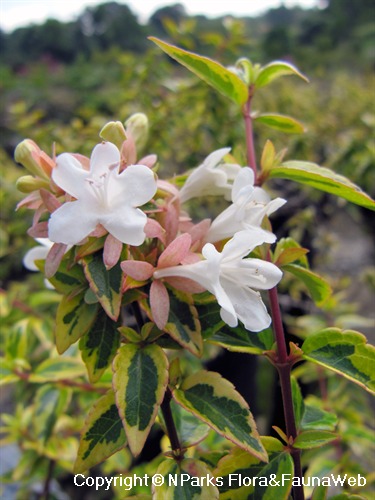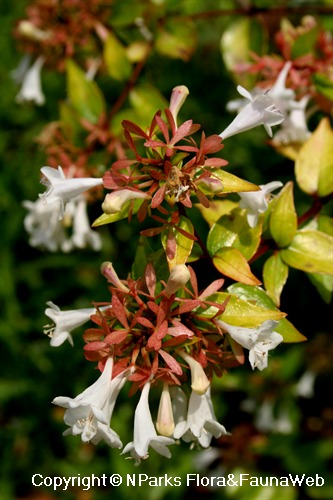
Back
Abelia × grandiflora 'Kaleidoscope'
| Family Name: | Caprifoliaceae |
| Common Name: | Kaleidoscope Abelia |
Name
Classifications and Characteristics
| Plant Division | Angiosperms (Flowering Seed Plants) (Dicotyledon) |
|---|---|
| Plant Growth Form | Shrub |
| Lifespan (in Singapore) | Perennial |
| Mode of Nutrition | Autotrophic |
| Plant Shape | Shrubby |
| Maximum Height | 60 cm to 70 cm |
| Maximum Plant Spread / Crown Width | 80 cm to 90 cm |
Biogeography
| Native Habitat | Terrestrial |
|---|---|
| Preferred Climate Zone | Temperate, Mediterranean |
| Local Conservation Status | Non-native (Horticultural / Cultivated Only) |
Description and Ethnobotany
| Growth Form | It is an evergreen compact shrub (semi-evergreen in colder area), which has an upright or spreading growth habit, up to 1.5 m tall. |
|---|---|
| Foliage | Leaves are variegated of yellow and green with a tinge of orange on the younger flushes, leaf blade is elliptical in shape, with crenate margin. Leaves are sometimes whorled or oppositely arranged. |
| Stems | Stems are woody, reddish in colour. |
| Flowers | Small, cluster, white funnel-shaped or trumpet-shaped flowers with pink sepals. Each flower has 5 lobes. |
| Etymology | Genus Abelia is named after Dr. Clarke Abel (1780-1826), who was a physician and writer on China. |
Landscaping Features
| Desirable Plant Features | Ornamental Flowers, Ornamental Foliage |
|---|---|
| Landscape Uses | Parks & Gardens, Small Gardens, Flowerbed / Border, Groundcover |
| Thematic Landscaping | Golden Garden, Naturalistic Garden |
Fauna, Pollination and Dispersal
| Fauna Pollination Dispersal Associated Fauna | Butterfly-Attracting |
|---|---|
| Pollination Method(s) | Biotic (Fauna) |
Plant Care and Propagation
| Light Preference | Full Sun |
|---|---|
| Water Preference | Moderate Water |
| Plant Growth Rate | Moderate |
| Rootzone Tolerance | Moist Soils, Well-Drained Soils, Fertile Loamy Soils |
| Maintenance Requirements | Moderate |
| Pruning | It is advisable to do thinning to stimulate branching. |
| Propagation Method | Stem Cutting (Herbaceous, Softwood, Semi-Hardwood) |
| Planting Distance | 60 cm to 70 cm |
Foliar
| Foliage Retention | Evergreen |
|---|---|
| Mature Foliage Colour(s) | Green - Light Green |
| Mature Foliage Texture(s) | Glossy / Shiny |
| Prominent Young Flush Colour(s) | Red |
| Young Flush Texture(s) | Glossy / Shiny |
| Foliar Type | Simple / Unifoliate |
| Foliar Arrangement Along Stem | Opposite |
| Foliar Attachment to Stem | Petiolate |
| Foliar Shape(s) | Non-Palm Foliage (Ovate) |
| Foliar Venation | Pinnate / Net |
| Foliar Margin | Serrate / Toothed |
| Foliar Apex - Tip | Acute |
Non - Foliar and Storage
| Root Type | Underground |
|---|
Floral (Angiosperm)
| Flower & Plant Sexuality | Bisexual Flowers |
| Flower Colour(s) | White |
|---|---|
| Flower Grouping | Cluster / Inflorescence |
| Flower Symmetry | Radial |
| Individual Flower Shape | Funnelform / Funnel-shaped |
| Flowering Period | Free-Flowering |
| Flowering Habit | Polycarpic |
Image Repository
Others
| Master ID | 30722 |
|---|---|
| Species ID | 5038 |
| Flora Disclaimer | The information in this website has been compiled from reliable sources, such as reference works on medicinal plants. It is not a substitute for medical advice or treatment and NParks does not purport to provide any medical advice. Readers should always consult his/her physician before using or consuming a plant for medicinal purposes. |





